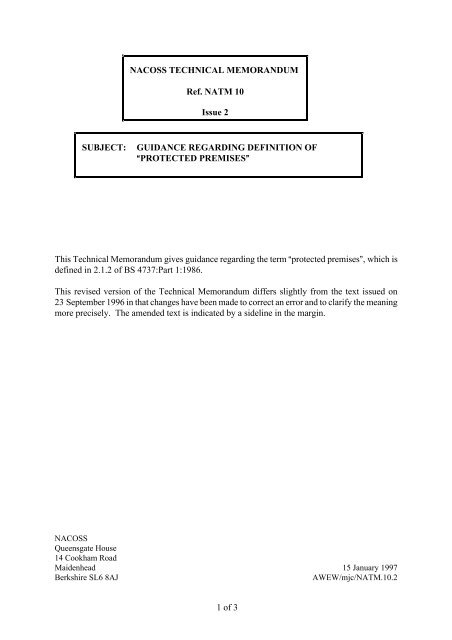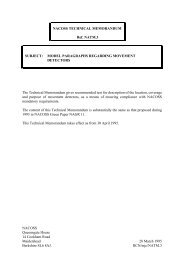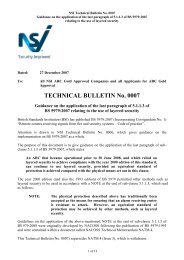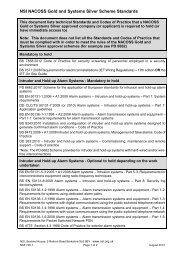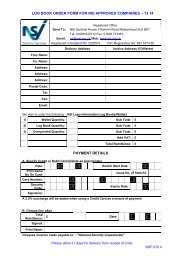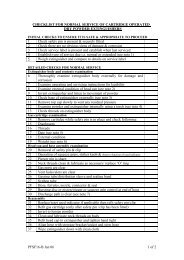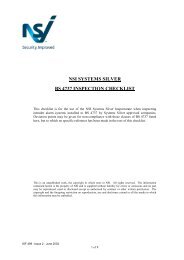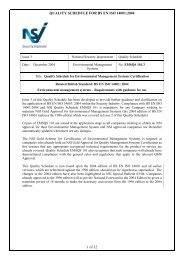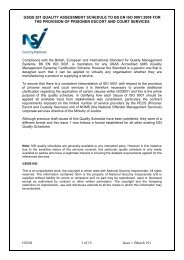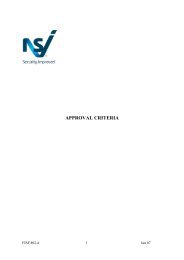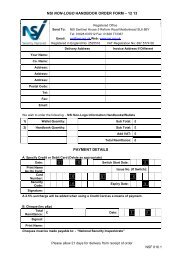1 of 3 NACOSS TECHNICAL MEMORANDUM Ref. NATM 10 Issue 2 ...
1 of 3 NACOSS TECHNICAL MEMORANDUM Ref. NATM 10 Issue 2 ...
1 of 3 NACOSS TECHNICAL MEMORANDUM Ref. NATM 10 Issue 2 ...
Create successful ePaper yourself
Turn your PDF publications into a flip-book with our unique Google optimized e-Paper software.
<strong>NACOSS</strong> <strong>TECHNICAL</strong> <strong>MEMORANDUM</strong><strong>Ref</strong>. <strong>NATM</strong> <strong>10</strong><strong>Issue</strong> 2SUBJECT:GUIDANCE REGARDING DEFINITION OFAPROTECTED PREMISES@This Technical Memorandum gives guidance regarding the term Aprotected premises@, which isdefined in 2.1.2 <strong>of</strong> BS 4737:Part 1:1986.This revised version <strong>of</strong> the Technical Memorandum differs slightly from the text issued on23 September 1996 in that changes have been made to correct an error and to clarify the meaningmore precisely. The amended text is indicated by a sideline in the margin.<strong>NACOSS</strong>Queensgate House14 Cookham RoadMaidenhead 15 January 1997Berkshire SL6 8AJAWEW/mjc/<strong>NATM</strong>.<strong>10</strong>.21 <strong>of</strong> 3
<strong>NACOSS</strong> <strong>TECHNICAL</strong> <strong>MEMORANDUM</strong> <strong>NATM</strong>.<strong>10</strong>.2GUIDANCE REGARDING DEFINITION OF APROTECTED PREMISES@The term Aprotected premises@ is defined in 2.1.2 <strong>of</strong> BS 4737:Part 1:1986, as follows:That part <strong>of</strong> a building to which protection is afforded by an intruder alarmsystem.The LEVEL <strong>of</strong> protection afforded by an intruder alarm system is <strong>of</strong> course a matter foragreement between the alarm company and its customer (in conjunction with any approvalrequired by the customer=s insurance company) having regard to such matters as the physicalsecurity <strong>of</strong> the building and the perceived level <strong>of</strong> risk.In some cases, for example, the parties may consider that it is sufficient for the intruder alarmsystem to cover only the exterior doors (e.g. by means <strong>of</strong> door switches (contacts), or movementdetectors covering the rooms/corridors onto which these doors open). In other cases, it may beconsidered prudent or necessary to Aalarm@ windows, ro<strong>of</strong>s, walls, etc. and/or to providemovement detection within various parts <strong>of</strong> the interior <strong>of</strong> the building.In order to verify compliance with BS 4737, it is necessary to identify whether or not certainpoints fall within the Aprotected premises@. For example, sub-clause 6.1 <strong>of</strong> BS 4737:Part 1:1986calls for control equipment to be Alocated within the protected premises@.For the purposes <strong>of</strong> verifying compliance with BS 4737, an intruder alarm system that isinstalled in accordance with an agreed system design specification is regarded by <strong>NACOSS</strong>as affording protection to an area if a person cannot enter or leave that area by anyNORMAL ROUTE <strong>of</strong> entry/exit without being detected by the intruder alarm system.In this context, the following are regarded as ANORMAL ROUTES <strong>of</strong> entry/exit@:-! by opening (or forcing open) a door (including entry/exit by forcing open a locked door),(except as stated in Note 2 below)! by opening (or forcing open) a french window (including entry/exit by forcing open alocked french window), (except as stated in Note 2 below)! by passing through rooms, along corridors, up/down stairways, etc.Note 1: Use <strong>of</strong> fire escapes (for entry or for exit) and/or opening or forcing open <strong>of</strong> fire exit doorsare regarded as ANORMAL ROUTES <strong>of</strong> entry/exit@.Note 2: Except where the door or french window opens onto an upstairs balcony having nostairway, in which case entry/exit involving climbing onto or lowering from thebalcony is not regarded as being a ANORMAL ROUTE <strong>of</strong> entry/exit@.2 <strong>of</strong> 3
Note 3: The term ANORMAL ROUTES <strong>of</strong> entry/exit@ (used in this <strong>NACOSS</strong> TechnicalMemorandum) should not be confused with the designated Aentry route@ andAexit route@ used when unsetting and setting the alarm system (see 2.1.6 and 2.1.7<strong>of</strong> BS 4737:Part 1:1986). ANORMAL ROUTE(S) <strong>of</strong> entry/exit@ includes thedesignated entry/exit route(s) plus any other route(s) falling within the descriptiongiven above.The following are examples <strong>of</strong> routes which are NOT regarded as being ANORMAL ROUTES <strong>of</strong>entry/exit@:-! through windows! through skylights! breaking through walls! through ro<strong>of</strong>s! by removing part <strong>of</strong> a door and entering without opening the door.3 <strong>of</strong> 3
4 <strong>of</strong> 3


